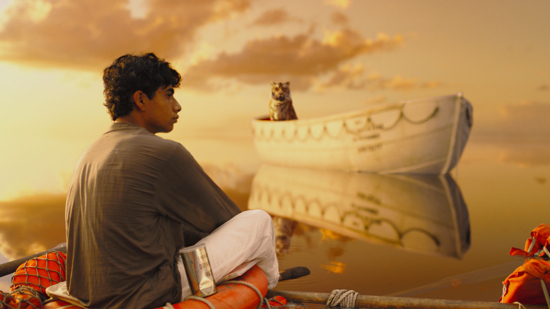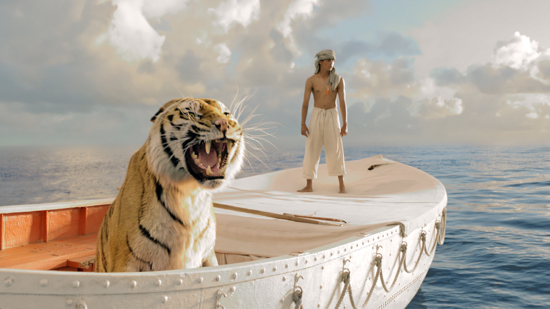The announcement that Ang Lee was to adapt Yann Martel’s critically praised novel was met with some understandable brow furrowing. Perhaps original directors M Night Shyamalan and Alfonso Cuarón decided it was too ungainly a task. The Man Booker Prize-winning book, which has sold over nine million copies since its 2001 release, was not only one of the greats of the 21st century so far but also deemed – that most green-light-dousing of phrases – unfilmable. Who wanted two hours of a boy and a tiger on a boat? Although the criticisms levelled at Lee for even attempting to adapt a book so religion-heavy and comprehensively weird may have been fair, it turns out he’s accomplished something almost as miraculous as the titular Pi’s story. Martel’s beloved novel could not have been in better hands.
An unnamed writer (Rafe Spall) is searching for inspiration for his latest book, and may have found the perfect source when he happens upon the story of one Pi Patel. Apparently, his tale has the power to make you believe in God. When Pi and his family ship the family zoo from the tumultuous Pondicherry, India with the intent of reaching the more temperate climes of Canada, their ship rudely sinks. What immediately entails comprises the bulk of this preternatural blockbuster: Pi is lost at sea, a bare white lifeboat his only salvation. Sharing this with him is a fully-grown adult Bengal tiger, by the name of Richard Parker. Only some kind of miracle will keep him alive.
And miraculously, the film’s fix on God never feels preachy. Instead, this concern with religion is refreshing in its refusal to let Pi’s unintentional seafaring slide into mere subtext. His story is related to us via an otherwise predictable framing device of an adult Pi and the Writer conversing, which at times spoon-feeds exposition, but ultimately serves as an important thematic cog. It’s akin in that regard to this year’s other fantastic film about storytelling, Miguel Gomes’ Tabu.
For the curiously named leading man himself, we’re treated to complete newcomer Suraj Sharma. Cast from an audition process involving no less than three thousand applicants, the young actor gets every note perfect. He dishes out dry humour when trying to impress a Pondicherry girl, conveys sky-cursing wrath when facing a deadly storm in the Pacific, and exhibits a deft aplomb for physicality when running away from his growly shipmate.
Narratively, Life of Pi revolves around the notion of a dream world, and to that effect seems born for CGI. To watch any one of the incredibly lyrical scenes, be it flying fish blitzing the boat or constellations of jellyfish illuminating the ebony ocean, is a genuine candy treat for the eyes, one that doesn’t sour with time. The greatest example of Lee’s mastery is Richard Parker’s astoundingly emotive (and emotional) interpretation, a mainly digital creature that somehow manages to resonate with our own hopes and fears during Pi’s salty sojourn. Digital is definitely Pi’s friend; his world couldn’t exist without it.

However, the CGI also works marginally to its own detriment. During scenes which don’t involve fantastical imagery (most notably the establishing Pondicherry sequences) it smacks of artificiality, and is not a beautiful thing. Also, its queer eye for the superficially unnecessary – a sequence in which it’s revealed the lead character is named after a French swimming pool – could be deemed as potentially jarring. But on the bigger canvas, these heteroclite passages only accentuate the picture’s adoration for alternative storytelling, factors which mean Martel’s original novel is wondrously intact onscreen, with even the more leftfield details included – overall, it exudes every quality that made the book so adored. Life of Pi translates brilliantly to the medium of cinema, simply by turning the philosophical angle of the novel from Do you believe what I’ve told you?, to Do you believe what I’ve shown you?
At its crux, that’s what this most unique of event movies is about: storytelling. Pi’s adventure is similar to our own. Like us, he’s a small fish in a very, very big ocean, searching for meaning in a lifeboat fashioned by our own abilities – or limitations. Everything that transpires feeds into allegory, or rather the power of allegory. This unabashed use of metaphor serves as the movie’s impetus, and would be heavy-handed in most director’s hands; Lee implicitly ignores suspension of disbelief and forges the ludicrous, yet heavily semantic. By letting us question what is actually happening on screen, he’s asking us to make the ultimate decision of belief: do bananas float? We’re dealing with highly intelligent, and more importantly emotional symbolism here. Will it make you believe in God, as Pi promises his story will? Perhaps not – but that’s not the point. Life of Pi asks you to make your own mind up.



